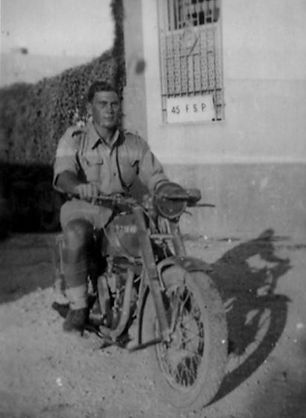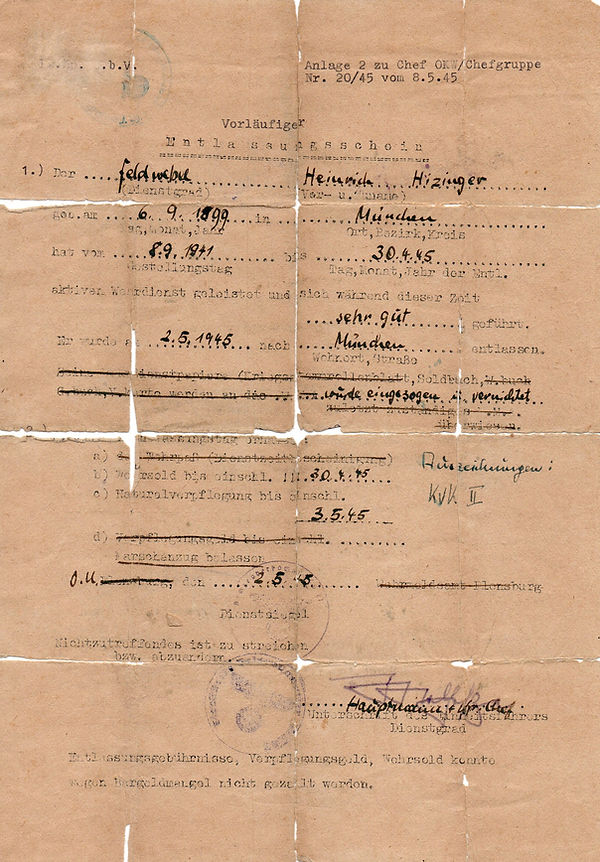The war in Europe officially ended on 8th May 1945 with allied forces victorious and, although Adolf Hitler had committed suicide, the allies were then intent on capturing other high-ranking Nazis responsible for many of the horrors of the past years.
On 22nd May 1945, SS Chief Heinrich Himmler, along with two other SS officers, were at Bremervörde, a small town on the River Oste between Hamburg and Bremerhaven in northern Germany, an area controlled by British forces.
The group were spotted near a British checkpoint. Two men, both of military bearing and wearing long green overcoats, were walking ahead of a third person (Himmler) who looked far less impressive in an odd selection of civilian garments with a blue raincoat on top.
The front two glanced back from time to time, seemingly to ensure that the third man was still with them. This odd-looking trio was picked up by an alert British infantry patrol, not knowing who they were, and were brought in to the checkpoint.


SS Reichsführer Heinrich Himmler's false identity document is donated to the museum
Himmler's arrest by Intelligence Corps
At the checkpoint, Sergeant Arthur Britton, seen here in Tunisia earlier in the war, and Sergeant Ken Baisbrown of 45 Field Security Section (FSS) Intelligence Corps, along with Staff Sergeant John Hogg of 1003 Field Security Reserve Detachment, made a quick scrutiny of their identity papers, and realised that all three were in an automatic arrest category.
Himmler’s disguise, he had shaved his distinctive moustache and was wearing an eyepatch, as well as looking dishevelled, still held and, as Feldwebel (Sergeant) Heinrich Hizinger, he fell under British military control.
The three men were given refreshments and a floor to sleep on at the checkpoint that night.
Himmler’s disguise, he had shaved his distinctive moustache and was wearing an eye patch, as well as looking dishevelled, still held and, he was not recognised for who he was.


Without giving the prisoners any clue that they would be sent for interrogation, Sergeant Britton then made out the arrest documents using the information contained on the identity papers.
The three men were given refreshments and a floor to sleep on at the checkpoint that night. Next morning, on 23rd May, the group were driven in a truck by Sgt Britton to No 031 Civil Internment Camp at Barnstedt.
At around 7 pm that night Himmler asked for an interview with the Internment Camp Commandant, Captain Thomas Selvester, Intelligence Corps, and for some reason revealed his true identity. Himmler's signature was checked against the prisoner's signature, and identification was complete.
Two body searches and a complete change of clothing failed to reveal any hidden poisons and at 9.45 pm Colonel Michael Murphy, Chief of Intelligence at HQ 2nd British Army, arrived to take personal charge of the prisoner.
He immediately arranged for a medical search to be carried out and it this was begun at 10.45 pm by Captain Wells, Royal Army Medical Corps, the HQ Medical Officer.
Having searched the prisoner thoroughly, Captain Wells came to the mouth, where he noticed a small blue object secreted in Himmler’s left cheek.
He slipped a finger into the prisoner's mouth to sweep out the object but Himmler immediately clamped down on the doctor's fingers, they struggled, Himmler wrenched his head away, crushed the glass capsule between his teeth, and the cyanide did its deadly work in ten minutes.
Himmler’s body underwent formal identification and autopsy by Allied staff officers and was then buried unceremoniously in an unmarked grave outside Lüneburg on 25th May 1945.

Himmler’s Entlassungsshein – A German failure
German service personnel leaving the forces at the close of the war were given an A4-sized, one page, paper identity document, an Entlassungsshein, which bore details of their name, rank, number, date of birth, unit and other administrative information. This would be presented to allied forces when asked for.
Himmler’s Entlassungsshein, was made out to another Heinrich, but one apparently named Hizinger, supposedly a Feldwebel, or Sergeant.
Bearing in mind the vast numbers of ex-forces personnel, refugees, displaced people and other travellers on the roads at this time, Himmler and his cronies might have felt some confidence in their false identities carrying them through cursory inspections.
It is also possible that German preconceptions, based on their own military hierarchy, led them to consider that the allies would never be interested in a 'mere' Sergeant.
They may have believed that by adopting an apparently ‘insignificant’ rank, Himmler would be able to pass through any capture system amidst the hundreds of thousands of other ‘insignificant’, ex-soldiers without being challenged.
What proved to be his undoing was that the Germans who completed his false Entlassungsshein were unaware that British forces knew that the unit stamp on the pass was being used to disguise Gestapo and SS members.
The arrest report made out by Sergeant Britton records that Hizinger was supposedly a member a 'Special Duties Armored Company' (Pz Kp Zbv) attached to the 'GFP (SD)'. This was the 'Geheime Feld Polizei (Sicherheitsdienst)' or Secret Field Police (Security Service).
The presence of the GFP unit stamp on Hizinger / Himmler's Entlassungsshein made him subject to automatic arrest and interrogation.
There would have been absolutely no chance that Himmler could have maintained his disguise under interrogation.
Had the Germans used a stamp from, say, an infantry or administration unit then it is possible that Himmler may have been able to pass through the system without being discovered.
It is a pleasing twist to the story that, by using this stamp, the Germans themselves made Himmler’s unmasking inevitable.


‘Lost and found’
In the aftermath of the capture, identification and suicide of one of the most infamous mass murderers of all time, a bout of military souvenir hunting took place and Himmler’s personal belongings were collected as keep-sakes.
Sergeant Britton got his slippers and, some years later, the Military Intelligence Museum were gifted Himmler’s shaving foam tube and some razor blades.
As soon as Himmler’s true identity became known, any military interest in his false identity document became superfluous. So, amidst the souvenir hunting free-for-all, the false Entlassungsshein was snapped up by persons unknown and effectively disappeared. Until 2019, when it was donated to the Military Intelligence Museum, along with the braces worn by Himmler at his capture, by members of the family of Lieutenant Colonel Sidney Noakes, Intelligence Corps.
MI5 involvement
Noakes, a lawyer in civilian life, was seconded to MI5 during the war.
On notes compiled for the documentation of Himmler’s arrest, a single, pencil annotation on the foot of the last page states ‘This story agreed by Mr Neil McDermott Q.C. formerly GSO1 (Int b) at HQ 21st Army Group’. McDermott enigmatically adds that ‘a gentle interrogation by M.I.5 reps also took place.’
McDermott, as a senior intelligence and security officer in the Headquarters would have been familiar with the conventional practice that members of MI5 are never named. And any MI5 approach to speak to Himmler would have had to be made through McDermott as GSO1 (Int b). As a fellow lawyer, it is also possible that McDermott and Noakes knew each other, even if only as fellow professionals.
Although we cannot be 100% certain, it is highly likely that Noakes was one of the MI5 officers mentioned in the footnote, giving him the opportunity to ‘acquire’ both the Entlassungsshein and the braces.
Hizinger vs Hitzinger
Although the original Arrest Report compiled by Sergeant Britton clearly shows the name Heinrich Hizinger, it has been considered by some that this spelling was a mistake by Britton, the name being recorded by many historians and commentators since as ‘Hitzinger’. With the original ID document having disappeared this discrepancy could not be clarified, until now.
The error, not of Britton’s making, probably comes from his pronunciation of the name Hizinger during interviews recorded after the war. Britton was actually Arthur Britton Schrynemakers, of Dutch heritage. He had adopted his middle name when he joined the British army after fleeing Belgium with other members of his family. Speaking Dutch, German and French as well as English, Arthur Britton’s transfer into the Intelligence Corps was almost inevitable.
It is quite easy to miss-hear Hizinger as being ‘Hitzinger’, a simple mistake easily made by non-German speakers and listeners.
However, Himmler’s Entlassungsshein clearly records the name as Hizinger and Sergeant Britton’s professional diligence in correctly transposing the name from ID document to Arrest Report can, at last, be confirmed.

